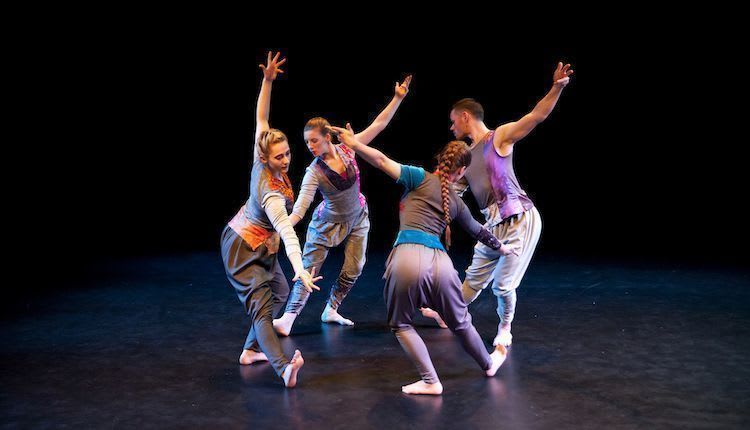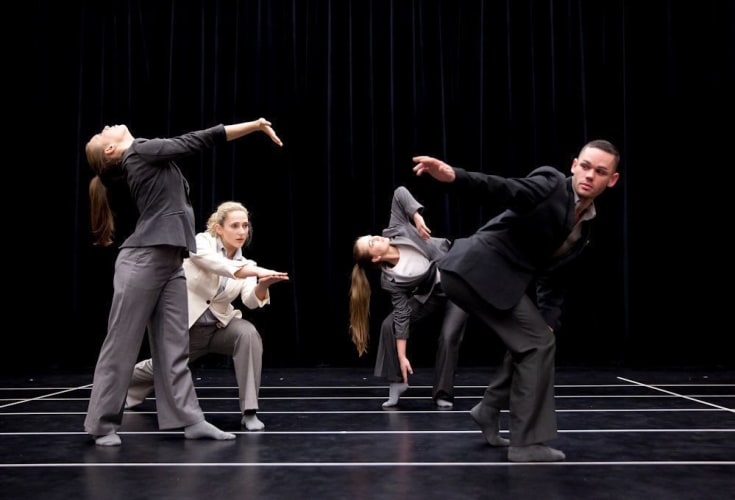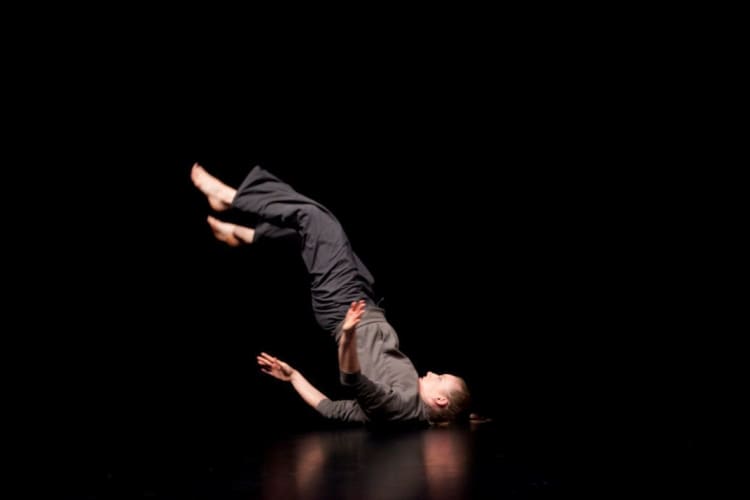Now in its second year and its second intake of four recently graduated North East-based dancers, Fertile Ground is touring the region with a triple bill: Elephant Dances by the company’s Artistic Director Dora Frankel, Eight Steps by Malgorzata Dzierzon and James Wilton’s Era.
It’s a very varied programme, making great demands on the skills of the young dancers: Emma Palmer, Emma Robinson, Abbie Ross and Niall Tyzack-Carlin.
The first piece is Dora Frankel’s Elephant Dances, a celebration of and homage to the elephant, which was inspired by the British Museum touring exhibition Celebrating Ganesha (Ganesha is the Hindu elephant-headed god) which is currently at the Bowes Museum in Barnard Castle where it will be performed on 25 June at 2:30.
In very low light, four dimly-visible, bulky shapes slowly cross the stage on all fours. Fade to black. A pause, then bright lights come up on the dancers, dressed in grey with different coloured highlights, performing the Indian dance form Kuchipudi.
Then, with a movement language which suggests the power and strength of these great beasts, the piece shows us all aspects of their life, including an unexpected playfulness danced to Stravinsky’s Petrushka. Here the choreography combines the puppet-like feel of the Stravinsky music with the elephant movement language to produce, at one point, a stage picture very reminiscent of the style of Indian art depictions of the Lord Ganesha.
It is during this section that the piece provides us with one of those rare moments of delighted laughter as a “baby elephant” scuttles (“bounces” might be a better word!) sideways and on her knees across the back of the stage, a big smile on her face. The audience laughed aloud and there were even a few "Ahs".
But the overall picture is one of impressive power—a fitting tribute.
Then we see Malgorzata Dzierzon’s Eight Steps. In the interval, two strips of masking tape have been laid from front to back of the stage, a metre or so in from either side, and the piece begins with three dancers using more tape to lay out a grid resembling a chessboard which fills much of the stage.
The grid is ever-present; we’re always conscious of it and for much of the time it seems to constrain the dancers’ movements. They are dressed in everyday wear—trousers, shirts and jackets—which firmly fixes them in time. This is now; this is life now.
There are solos, duets, trios. Sometimes all work together. Occasionally they move in unison, occasionally they interact and occasionally they are together yet separate—individuals in parallel spaces, not relating to each other. Although the movement can be flowing, most often it is constrained, sometimes even robotic, and, much of the time—but particularly noticeable when it is robotic—there is a sense of desperation.
Finally, James Wilton’s Era brings us into the world of mobile 'phones and Facebook. It begins in darkness with lights seeming to crawl slowly across the stage. At first I thought they were torches but no, these are mobile 'phone screens and so central are they to the lives of the characters that we are forced to wonder who is actually in control, the 'phone or its person.
As I travelled to Newcastle on the Tyne and Wear Metro, around two thirds of the people in the carriage were sitting staring at their 'phones, some (to judge by the finger movements) texting but the majority swiping through Facebook or Twitter posts or something of that nature. No one was actually using it to talk to someone else.
And here was the same thing on the stage in front of me. Can these people actually establish a relationship? Communicate with another person face to face? As Wilton’s programme note suggests, can you even know what you actually like when you have favourited so much?
As the piece progresses, there is a palpable feeling of frustration, even desperation, which builds to an explosive physicality reminiscent of Win Vanderkybus’s What the Body Does Not Remember as the dancers fling themselves to the ground with such energy that it evoked gaps of shock from the audience.
The final image is of a man and a woman clinging to each other which brought more “ahs” from the group of teenage girls from a local school who were sitting behind me, but this wasn’t a romantic happy ending—it was more akin to Sylvia Plath’s “Not waving but drowning”.
Two dystopian looks at modern society preceded by a celebration of one of nature’s noblest and powerful animals make for an intriguing and very enjoyable evening of dance from three established choreographers and four young dancers who will go far.


